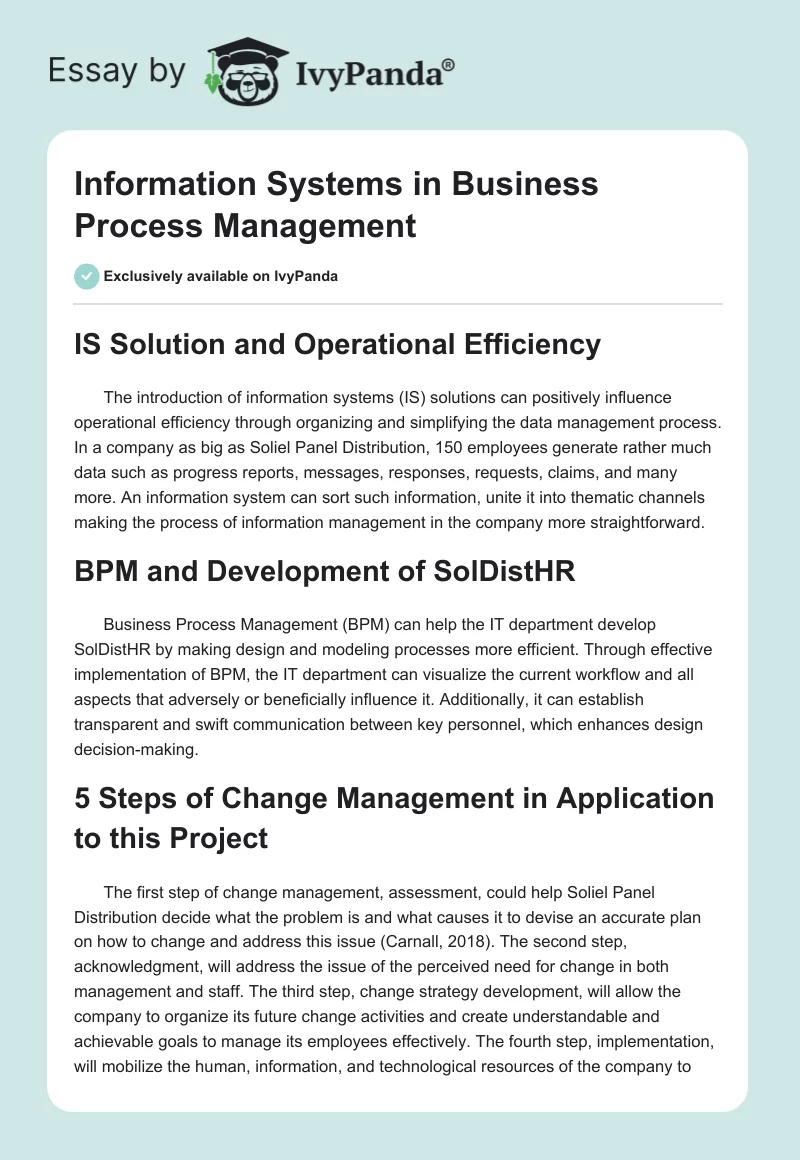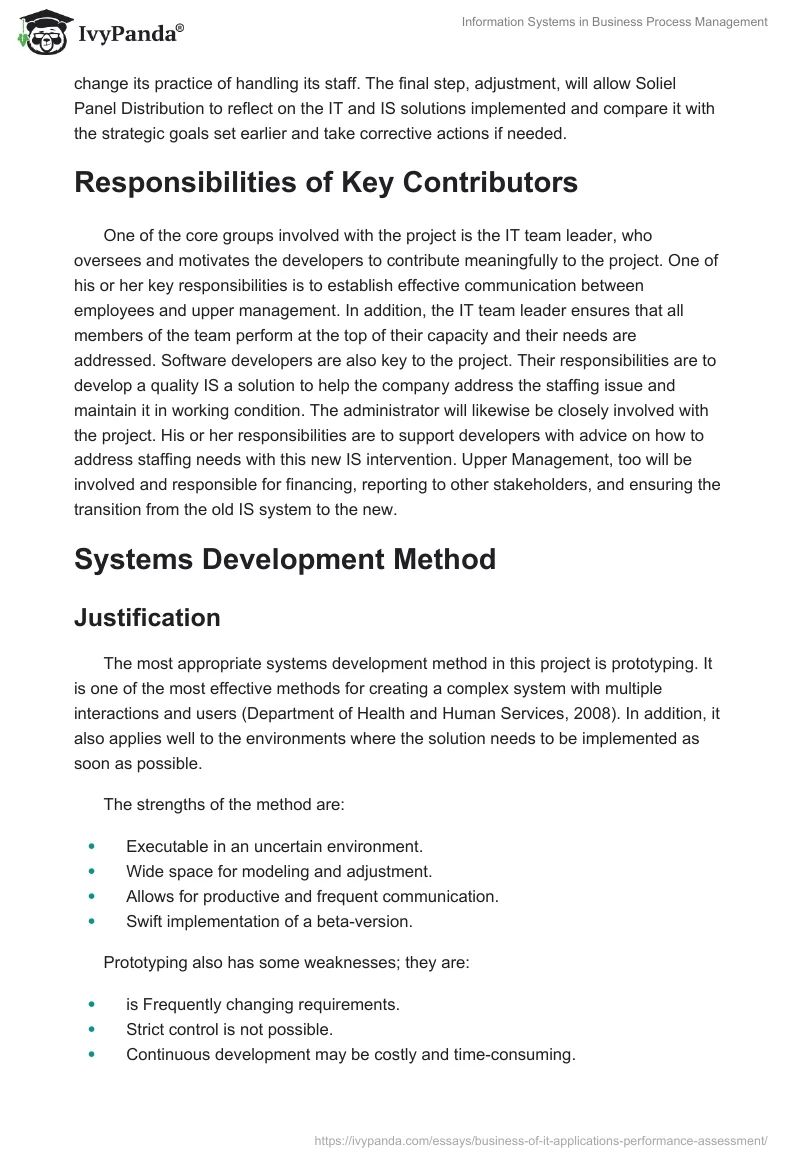IS Solution and Operational Efficiency
The introduction of information systems (IS) solutions can positively influence operational efficiency through organizing and simplifying the data management process. In a company as big as Soliel Panel Distribution, 150 employees generate rather much data such as progress reports, messages, responses, requests, claims, and many more. An information system can sort such information, unite it into thematic channels making the process of information management in the company more straightforward.
BPM and Development of SolDistHR
Business Process Management (BPM) can help the IT department develop SolDistHR by making design and modeling processes more efficient. Through effective implementation of BPM, the IT department can visualize the current workflow and all aspects that adversely or beneficially influence it. Additionally, it can establish transparent and swift communication between key personnel, which enhances design decision-making.
5 Steps of Change Management in Application to this Project
The first step of change management, assessment, could help Soliel Panel Distribution decide what the problem is and what causes it to devise an accurate plan on how to change and address this issue (Carnall, 2018). The second step, acknowledgment, will address the issue of the perceived need for change in both management and staff. The third step, change strategy development, will allow the company to organize its future change activities and create understandable and achievable goals to manage its employees effectively. The fourth step, implementation, will mobilize the human, information, and technological resources of the company to change its practice of handling its staff. The final step, adjustment, will allow Soliel Panel Distribution to reflect on the IT and IS solutions implemented and compare it with the strategic goals set earlier and take corrective actions if needed.
Responsibilities of Key Contributors
One of the core groups involved with the project is the IT team leader, who oversees and motivates the developers to contribute meaningfully to the project. One of his or her key responsibilities is to establish effective communication between employees and upper management. In addition, the IT team leader ensures that all members of the team perform at the top of their capacity and their needs are addressed. Software developers are also key to the project. Their responsibilities are to develop a quality IS a solution to help the company address the staffing issue and maintain it in working condition. The administrator will likewise be closely involved with the project. His or her responsibilities are to support developers with advice on how to address staffing needs with this new IS intervention. Upper Management, too will be involved and responsible for financing, reporting to other stakeholders, and ensuring the transition from the old IS system to the new.
Systems Development Method
Justification
The most appropriate systems development method in this project is prototyping. It is one of the most effective methods for creating a complex system with multiple interactions and users (Department of Health and Human Services, 2008). In addition, it also applies well to the environments where the solution needs to be implemented as soon as possible.
The strengths of the method are:
- Executable in an uncertain environment.
- Wide space for modeling and adjustment.
- Allows for productive and frequent communication.
- Swift implementation of a beta-version.
Prototyping also has some weaknesses; they are:
- is Frequently changing requirements.
- Strict control is not possible.
- Continuous development may be costly and time-consuming.
- Difficult to plan beforehand (Department of Health and Human Services, 2008).
Execution of Milestones
Firstly, the initial requirements will be defined in collaboration with the administrator, IT department, and upper management. Then, a reiterative cycle of coding and systems design will be initiated. As soon as the beta version of SolDistHR is deployed to a test server, certain employees, including administrators, will use it and give developers their feedback. This feedback will be used to adjust the system and fix bugs until the final solution is ready and implemented for every HR manager and related employee. After this stage, the IT team will continuously support and maintain SolDistHR in working condition, improving its performance, stability, and usability.
Post-Implementation Internal and External Threats
One of the possible internal threats is the compatibility of the developed solution with the current hardware installed in the company offices. In addition, the organization may face the need to re-educate the staff to operate the new system or hire more competent employees as the new system will be too complex. Among external threats, one may identify the loss of interest to the conventional solar panels as the new and more effective solutions may enter the market, which will trigger a shortage of project maintenance. In addition, competitors may recruit key employees responsible for maintenance which can undermine the stability of the project operation.
Post-Implementation Physical and Digital Threats
Among physical threats, there might be damage to servers that contain all the data stored within SolDistHR. This will result in the paralysis of all staffing activities. Electricity outages can also temporarily disrupt the software operation and, therefore, undermine the stability of the company’s performance. Additionally, employees may steal corporate data using their physical access privileges.
One of the most severe digital threats is a hacker attack. The practices of corporate espionage may compromise the HR-related information of the company and undermine its operational and financial stability. In addition to unwanted access, improper or uneducated use such as wrong data insertion or formatting errors may create chaos and hider the performance of the software. Unfixed bugs in the code may surface and disrupt the work of the HR department because the project is complex and multifaceted.
Troubleshooting and Recovery After Failure
Due to the fact that SolDistHR is a complex system, there is a need for a systematic troubleshooting approach. Under this model, the first step will be to observe and monitor the arising problems and classify them into categories or areas such as technical issues and bugs, user interface questions, and so on. Next, there is a need to establish reasons for the identified issues to tackle the source. Finally, judging from the source and the nature of the problem, responsible and able parties should be instructed to eliminate the issues. Should the project fail completely, a recovery response might be needed.
Thus, the first step to recovery would be to identify and analyze the roots of the failure. Depending on the gravity of issues, the project may be recovered with small changes, major adjustments, and additional budget costs or canceled. In case if the project can be revived, the previous analysis will offer ideas for recovery. Next, in the tradeoff phase, possible project revival options should be elaborated and submitted to stakeholders. After negotiation and forging an agreement on one of them, the IT department should, with the account of the previous mistakes, act on the changed project. After implementing an updated version of SolDistHR, feedback from the users should be collected, and the matters should be regarded as resolved or returned for additional fixes using the same scheme.
Importance and Functions of Problem Management
The importance of problem management (PM) can in part be explained by the fact that in complex IS projects, the amount of uncertainty is very high, and planning may not always identify and prevent possible issues. The soldier is an environment that encompasses many functions, and the more of them it will have, the more problems may arise. It is, therefore, essential to employ a suitable PM paradigm to have the ability to save the project from failure. In addition, PM may help locate small issues and prevent them from growing into major ones. Finally, PM may help completely prevent the company from certain problems if they are identified beforehand and communicated to the IT team, management, and other parties involved with the project.
Incident Management Steps
The first step to incident management is to establish the technical means to report the incident. Within SolDistHR, there should be a form to report an incident and classify it. Next, the problem should be evaluated as per its urgency (urgent/non-urgent/moderately urgent), complexity (minor/serious/critical), and nature (back-end, front-end, system) and forwarded to the appropriate IT specialist by the incident response team for correction (Owen, Hayes, Brooks, Cameron, & Conway, 2018).
On the third step, the person or a department who submitted the incident report should be notified upon maintenance completion and result. The final step involves gathering feedback and closing or reopening the claim. The implementation of this incident management paradigm will require the addition of an incident response team that establishes a connection among management, employees, and IT department.
References
Carnall, C. (2018). Managing change. London, UK: Routledge.
Department of Health and Human Services. (2008). Selecting a development approach. Web.
Owen, C., Hayes, P., Brooks, B., Cameron, S., & Conway, G. (2018). Evidence to support incident management team capability. Australian Journal of Emergency Management, 33(3), 44-54.


